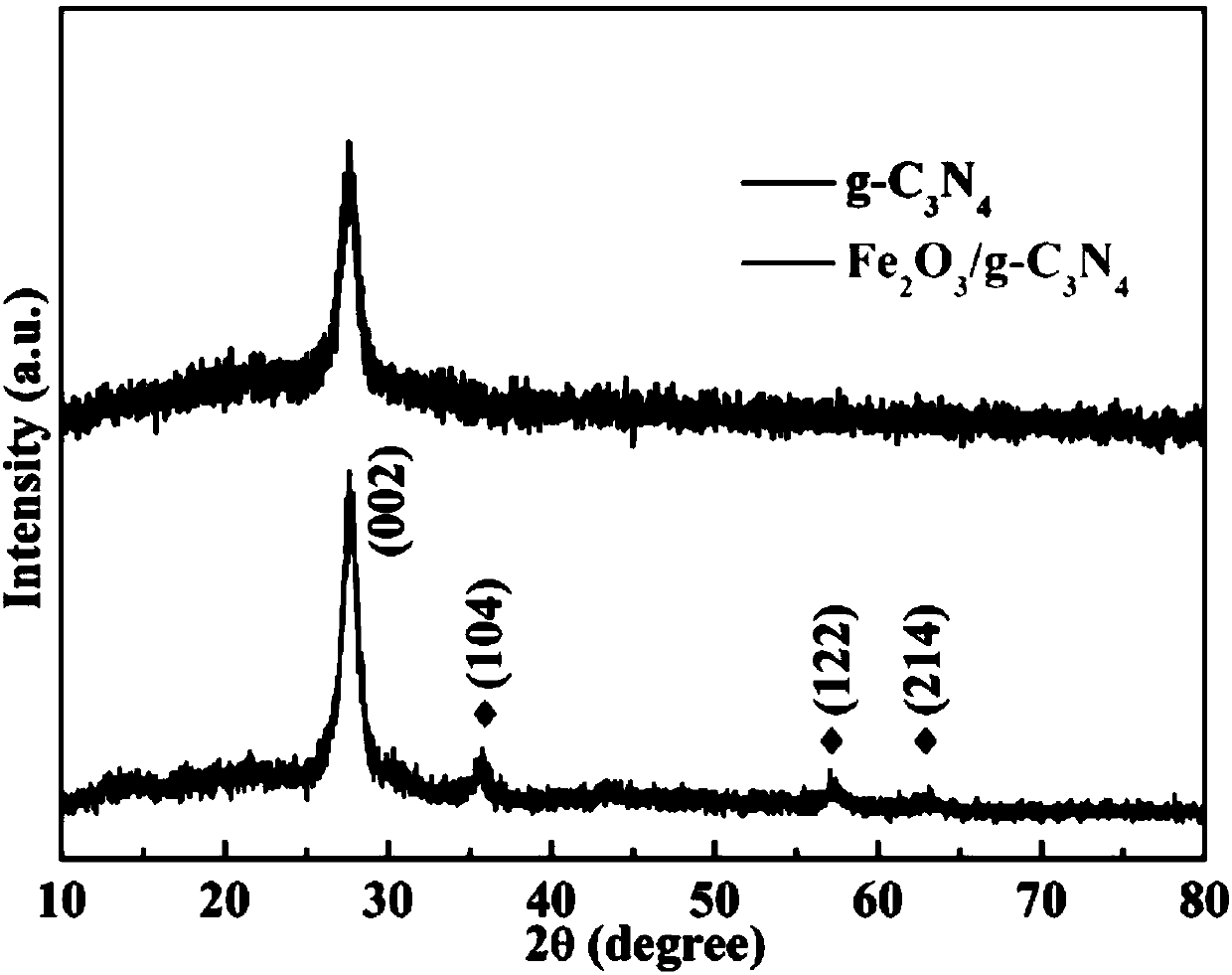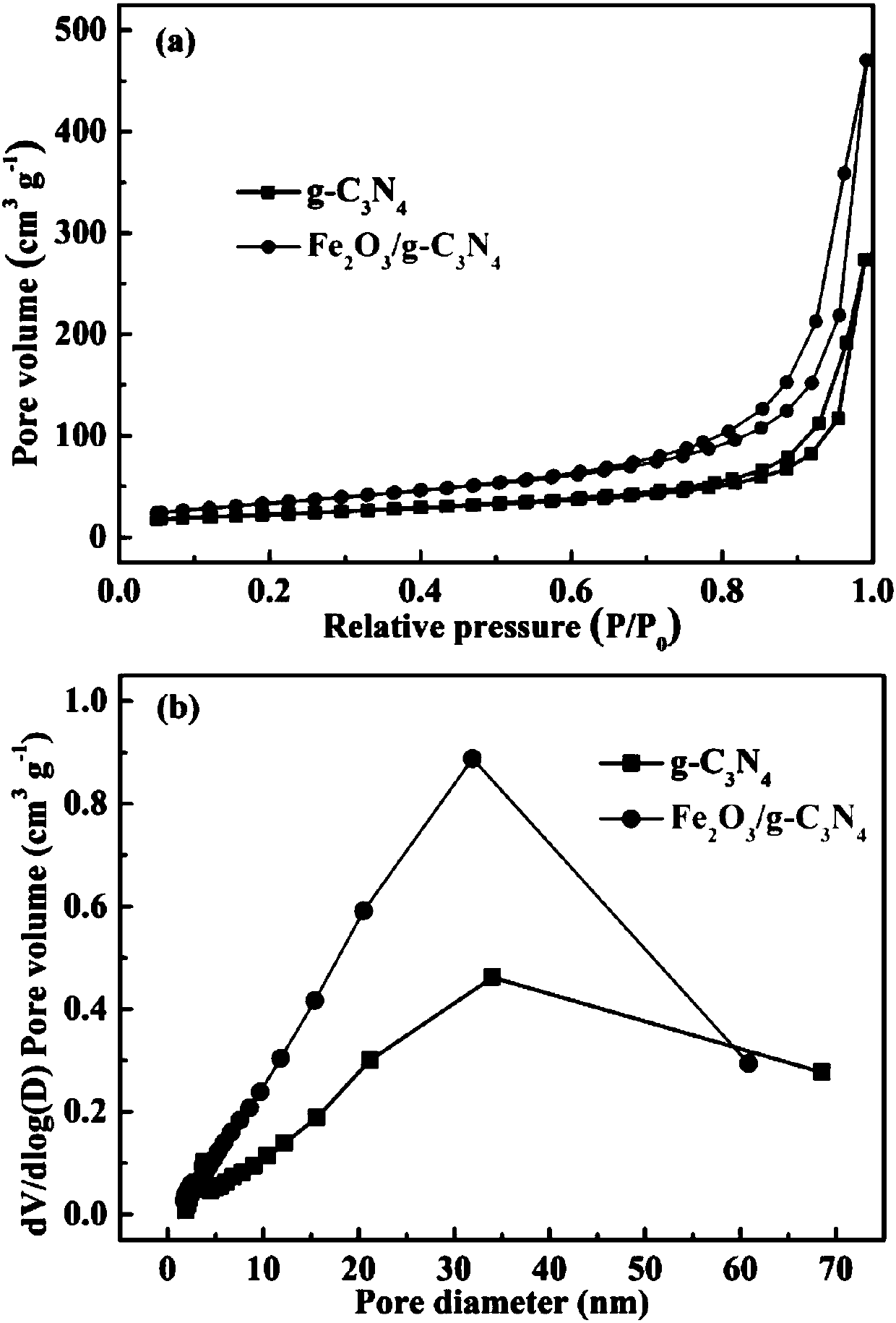Fe2O3/g-C3N4 composite system and preparation method and application thereof
A fe2o3, 1.fe2o3 technology, applied in the field of photocatalyst synthesis, to achieve excellent photocatalytic activity, facilitate mass production, and convenient operation
- Summary
- Abstract
- Description
- Claims
- Application Information
AI Technical Summary
Problems solved by technology
Method used
Image
Examples
Embodiment 1
[0035] Example 1: Mesoporous "Z-Scheme" type Fe 2 o 3 / g -C 3 N 4 Preparation of composite system
[0036] 1. Preparation of g-C 3 N 4 catalyst of light
[0037] 1. Weigh urea, dry it in an oven at 80°C for 24 hours, grind it and put it into a crucible, cover it, and place it in a muffle furnace at 2°C min -1 The heating rate is from room temperature to 550°C, and calcined for 4h.
[0038] 2. Use 1mol L after taking it out -1 Soak and stir in nitric acid for 24 hours, filter, wash with distilled water 7-8 times until neutral, and dry in an oven at 80°C for 24 hours.
[0039] 3. Take out the sample and grind it, place it in a crucible, and calcinate it in a muffle furnace at 500°C for 4 hours without a cover to obtain mesoporous g-C 3 N 4 catalyst of light.
[0040] 2. Preparation of mesoporous “Z-Scheme” Fe 2 o 3 / g -C 3 N 4 Composite system
[0041] 1. Accurately weigh 0.2g of P123 and 0.1g of hexamethyleneimine, dissolve in a mixed solution of 16.5ml of absol...
Embodiment 2
[0048] Example 2: Mesoporous "Z-Scheme" type Fe 2 o 3 / g -C 3 N 4 Preparation of composite system
[0049] 1. Preparation of g-C 3 N 4 catalyst of light
[0050] 1. Weigh urea, dry it in an oven at 80°C for 24 hours, grind it and put it into a crucible, cover it, and place it in a muffle furnace at 2°C min -1 The heating rate is from room temperature to 550°C, and calcined for 4h.
[0051] 2. Use 1mol L after taking it out -1 Soak and stir in nitric acid for 24 hours, filter, wash with distilled water 7-8 times until neutral, and dry in an oven at 80°C for 24 hours.
[0052] 3. Take out the sample and grind it, place it in a crucible, and calcinate it in a muffle furnace at 500°C for 4 hours without a cover to obtain mesoporous g-C 3 N 4 catalyst of light.
[0053] 2. Preparation of mesoporous “Z-Scheme” Fe 2 o 3 / g -C 3 N 4 Composite system
[0054] 1. Accurately weigh 0.2g of P123 and 0.1g of hexamethyleneimine, dissolve in a mixed solution of 16.5ml of absol...
Embodiment 3
[0061] Example 3: Mesoporous "Z-Scheme" type Fe 2 o 3 / g -C 3 N 4 Preparation of composite system
[0062] 1. Preparation of g-C 3 N 4 catalyst of light
[0063] 1. Weigh urea, dry it in an oven at 80°C for 24 hours, grind it and put it into a crucible, cover it, and place it in a muffle furnace at 2°C min -1 The heating rate is from room temperature to 550°C, and calcined for 4h.
[0064] 2. Use 1mol L after taking it out -1 Soak and stir in nitric acid for 24 hours, filter, wash with distilled water 7-8 times until neutral, and dry in an oven at 80°C for 24 hours.
[0065] 3. Take out the sample and grind it, place it in a crucible, and calcinate it in a muffle furnace at 500°C for 4 hours without a cover to obtain mesoporous g-C 3 N 4 catalyst of light.
[0066] 2. Preparation of mesoporous “Z-Scheme” Fe 2 o 3 / g -C 3 N 4 Composite system
[0067] 1. Accurately weigh 0.2g of P123 and 0.1g of hexamethyleneimine, dissolve in a mixed solution of 16.5ml of absol...
PUM
 Login to View More
Login to View More Abstract
Description
Claims
Application Information
 Login to View More
Login to View More - R&D
- Intellectual Property
- Life Sciences
- Materials
- Tech Scout
- Unparalleled Data Quality
- Higher Quality Content
- 60% Fewer Hallucinations
Browse by: Latest US Patents, China's latest patents, Technical Efficacy Thesaurus, Application Domain, Technology Topic, Popular Technical Reports.
© 2025 PatSnap. All rights reserved.Legal|Privacy policy|Modern Slavery Act Transparency Statement|Sitemap|About US| Contact US: help@patsnap.com



